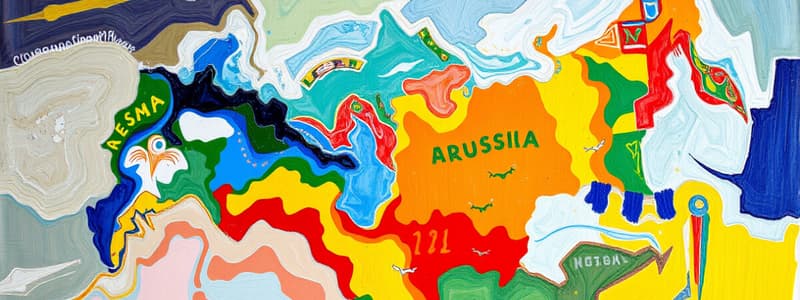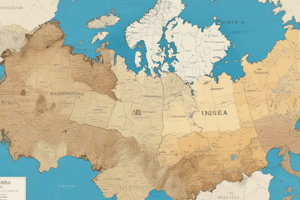Podcast
Questions and Answers
What significant geographic feature contributed to the concentration of Russia's population west of the Ural Mountains?
What significant geographic feature contributed to the concentration of Russia's population west of the Ural Mountains?
- The availability of more fertile land (correct)
- The harsh arctic tundra climate
- The proximity to the Baltic Sea
- The presence of large desert areas
Which city in the Russian Empire is mentioned as having extreme winter temperatures in Yakutsk?
Which city in the Russian Empire is mentioned as having extreme winter temperatures in Yakutsk?
- Moscow
- Kazakhstan
- Yakutsk (correct)
- St Petersburg
What percentage of Russia's population lived in towns or cities of over 100,000 inhabitants in 1855?
What percentage of Russia's population lived in towns or cities of over 100,000 inhabitants in 1855?
- 10%
- 5.4%
- 2.8%
- 1.6% (correct)
Which climate is described as present on the coast of the Black Sea?
Which climate is described as present on the coast of the Black Sea?
What was the approximate population of the Russian Empire as recorded in the 1897 census?
What was the approximate population of the Russian Empire as recorded in the 1897 census?
Which group of people was subjected to severe restrictions and confined to the Jewish Pale of Settlement?
Which group of people was subjected to severe restrictions and confined to the Jewish Pale of Settlement?
What type of vegetation is most likely to be found in the treeless arctic tundra region of Russia?
What type of vegetation is most likely to be found in the treeless arctic tundra region of Russia?
What lifestyle did the Tungus people primarily follow in Northern Siberia?
What lifestyle did the Tungus people primarily follow in Northern Siberia?
What was the staple diet of peasants during the 19th century?
What was the staple diet of peasants during the 19th century?
What responsibilities did the Mir have regarding the peasant community?
What responsibilities did the Mir have regarding the peasant community?
What limited the ability of serfs to innovate in farming?
What limited the ability of serfs to innovate in farming?
What was the primary language used in the courts and higher education in Russia during the 19th Century?
What was the primary language used in the courts and higher education in Russia during the 19th Century?
Which Tsar absorbed Poland into Russia after a revolt in 1830?
Which Tsar absorbed Poland into Russia after a revolt in 1830?
What was a significant consequence of illiteracy among the peasant population?
What was a significant consequence of illiteracy among the peasant population?
What percentage of Russian exports was accounted for by grain around 1855?
What percentage of Russian exports was accounted for by grain around 1855?
How was the Orthodox Church structured in relation to the State?
How was the Orthodox Church structured in relation to the State?
What major challenge did Russia face in terms of industrial development in the 19th Century?
What major challenge did Russia face in terms of industrial development in the 19th Century?
Why was there a paradox in the life of wealthy landlords?
Why was there a paradox in the life of wealthy landlords?
What was the average life expectancy of peasants in the second half of the 19th century?
What was the average life expectancy of peasants in the second half of the 19th century?
In 1855, how much railway did Russia have compared to Britain?
In 1855, how much railway did Russia have compared to Britain?
What role did religion play in Russian peasant life?
What role did religion play in Russian peasant life?
What was the primary cause of the stagnation of the Russian economy by 1855?
What was the primary cause of the stagnation of the Russian economy by 1855?
Why did the Old Believers break away from the official Orthodox Church?
Why did the Old Believers break away from the official Orthodox Church?
What role did 'holy men' play in the Orthodox Christian community?
What role did 'holy men' play in the Orthodox Christian community?
What action did Nicholas I take to counter the spread of democratic ideas?
What action did Nicholas I take to counter the spread of democratic ideas?
Who controlled most of the industrial enterprises in Russia at the beginning of the 19th Century?
Who controlled most of the industrial enterprises in Russia at the beginning of the 19th Century?
How was the Orthodox Church perceived in relation to the Tsar's authority?
How was the Orthodox Church perceived in relation to the Tsar's authority?
What was a significant advantage for the Russian cotton industry in the early 19th Century?
What was a significant advantage for the Russian cotton industry in the early 19th Century?
What was one of the reasons for the lack of a strong middle class in 19th-century Russia?
What was one of the reasons for the lack of a strong middle class in 19th-century Russia?
What was the state of the population in European Russia by 1855?
What was the state of the population in European Russia by 1855?
What were Jewish communities subject to in Russia?
What were Jewish communities subject to in Russia?
What was the central theme of royal government during Nicholas I's rule?
What was the central theme of royal government during Nicholas I's rule?
What was the main focus of critics of the Tsarist regime?
What was the main focus of critics of the Tsarist regime?
How did the Tsar exert control over peasants regarding life decisions?
How did the Tsar exert control over peasants regarding life decisions?
By 1850, the Russian cotton industry ranked what in the world?
By 1850, the Russian cotton industry ranked what in the world?
What was a major consequence of the oppressive structure of serfdom?
What was a major consequence of the oppressive structure of serfdom?
What kind of political system did the Tsar of Russia believe in?
What kind of political system did the Tsar of Russia believe in?
What condition was imposed on serfs by the landowners in the 18th century?
What condition was imposed on serfs by the landowners in the 18th century?
How large was the personal fortune estimated for Tsar Nicholas II upon his ascension?
How large was the personal fortune estimated for Tsar Nicholas II upon his ascension?
In what way did religious icons function in the lives of peasants?
In what way did religious icons function in the lives of peasants?
Which area experienced significant industrial growth among Russian industries during the first half of the 19th century?
Which area experienced significant industrial growth among Russian industries during the first half of the 19th century?
What was the economic situation in Russia's rural areas by the mid-19th century?
What was the economic situation in Russia's rural areas by the mid-19th century?
What was the perception of the Tsar among the serfs?
What was the perception of the Tsar among the serfs?
What approach did the Tsar take in his governance principles?
What approach did the Tsar take in his governance principles?
In the 19th Century, which feature of Russia limited its trade activities?
In the 19th Century, which feature of Russia limited its trade activities?
What was the significant challenge of ruling the Russian Empire noted in the content?
What was the significant challenge of ruling the Russian Empire noted in the content?
Flashcards are hidden until you start studying
Study Notes
Geography of Russia
- The Russian Empire in 1855 spanned 6,000 miles from the Baltic Sea to the Pacific Ocean, and 2,000 miles from north to south.
- Significant climate diversity existed, leading to varied lifestyles among its inhabitants.
- Yakutsk experiences extreme temperatures, ranging from -60°C in winter to nearly 40°C in summer.
- Northern Siberia has only two summer months for vegetation growth, while the Black Sea coast enjoys a sub-tropical climate.
- The Caspian Sea area consists of large desert or semi-desert regions, covering about 20% of Russia’s territory.
- Population was mainly concentrated west of the Ural Mountains, with major cities like St Petersburg and Moscow.
- In 1855, only 1.6% of the population lived in cities with over 100,000 residents.
The People of Russia
- Rapid population growth occurred in the latter half of the 19th Century, rising from 70 million in 1855 to 126 million by 1897.
- Over 100 nationalities were present in the Empire, each with distinct languages and cultures, including the nomadic Tungus.
- The Jewish community in Russia was the largest globally yet faced severe restrictions and persecution, including being confined to the Pale of Settlement.
- Tsarist rule suppressed national aspirations, promoting Russian language and Orthodox Church influence throughout the empire.
- In 1830, the Polish revolt led to the abolition of their constitution and incorporation into the Russian Empire.
The Russian Economy
- Historical efforts by Peter the Great and Catherine the Great to modernize Russia yielded limited success.
- The economy suffered from outdated farming techniques and poor soil quality, placing strains on resources as the population grew.
- Grain was the primary export, making up about 40% of Russia's economic value, while raw materials were exported in exchange for finished goods.
- Inefficient trade due to lack of year-round ice-free ports hindered economic growth.
- By 1860, Russia boasted 1,600 km of railway compared to Britain's 15,000 km, complicating transport of goods.
- Industrial development was impeded by an underdeveloped banking system; most workers were bound by serfdom.
- The textile sector saw some growth, particularly in cotton production, partly due to high tariffs and the Napoleonic Wars shielding local industries.
Russian Society
- Approximately 96% of the population lived in rural areas, with 50 million serfs working under harsh conditions by 1855.
- Peasants lived under oppressive conditions; could be sold or punished, and their livelihoods depended on their landlords.
- Daily diet consisted mainly of cabbage soup and rye bread; living conditions were poor.
- The Mir village community regulated peasants' lives, from tax collection to soldier selection, limiting personal autonomy.
- Many nobles faced financial strain due to debts, compelling them to sell land and rely on managers for estate oversight.
- A small educated middle class began to emerge, though education remained limited, with less than 1% of the population enrolled in schools by Nicholas I's death in 1855.
Religion in Russia
- Orthodox Christianity was deeply ingrained in Russian society, with religious practices integrated into daily life.
- Churches were bajo state control, with the Holy Synod managing religious affairs under the Tsar's authority.
- The church reinforced obedience to both divine and state authority, contributing to the status quo.
- Jews faced systematic discrimination and violence, constrained in their social mobility and subjected to pogroms.
The Tsar and His Family
- The Tsar and the royal family epitomized social privilege, with all elite social life centered around the court.
- Nicholas II's wealth was estimated at $20 billion, with vast landholdings emphasizing his status.
- The Tsar represented autocracy, believing in absolute power over governance and subjects, who were ideally obedient and equal before him.
- Critics typically focused on corrupt officials rather than the concept of autocracy itself.
- Autocracy was seen as necessary for controlling Russia's vast, diverse population and preventing external threats.
- Distance between the Tsar and the peasantry meant local officials often absorbed blame for governance issues.
Studying That Suits You
Use AI to generate personalized quizzes and flashcards to suit your learning preferences.




